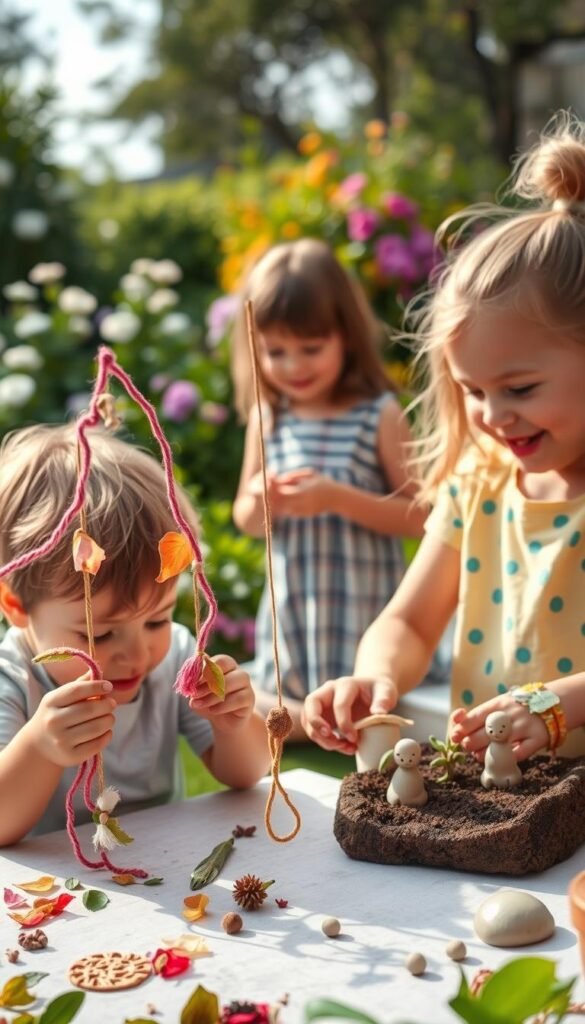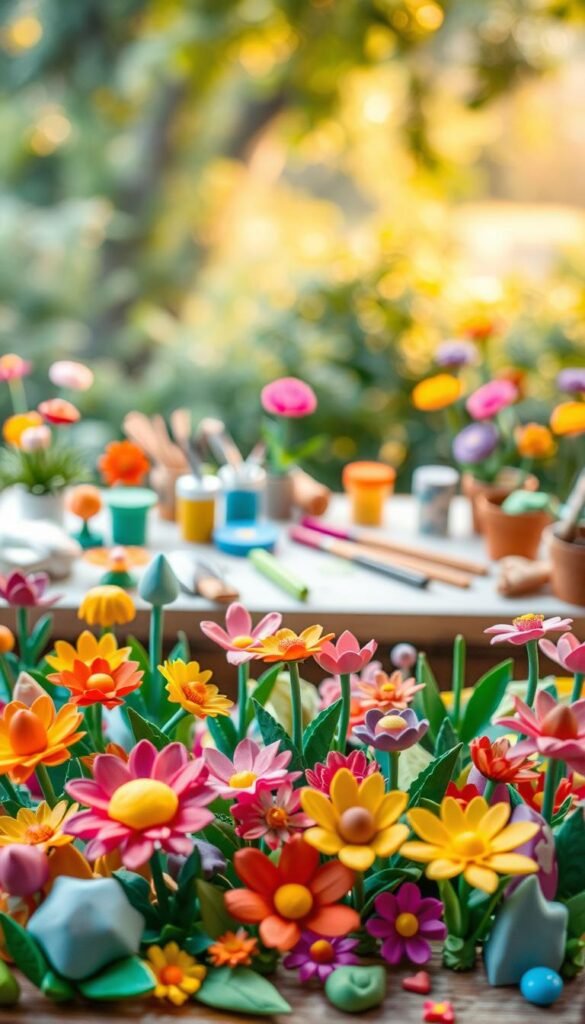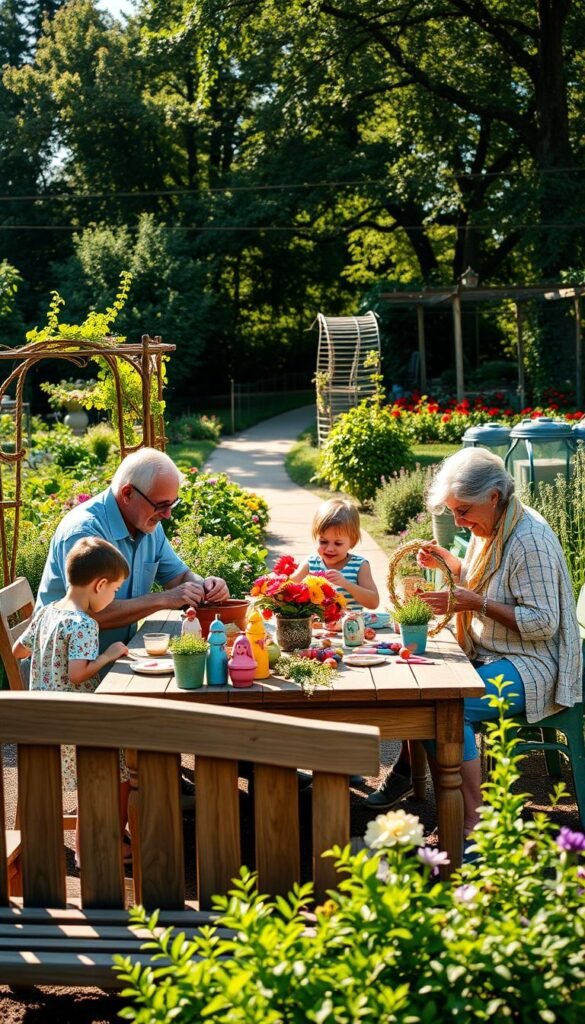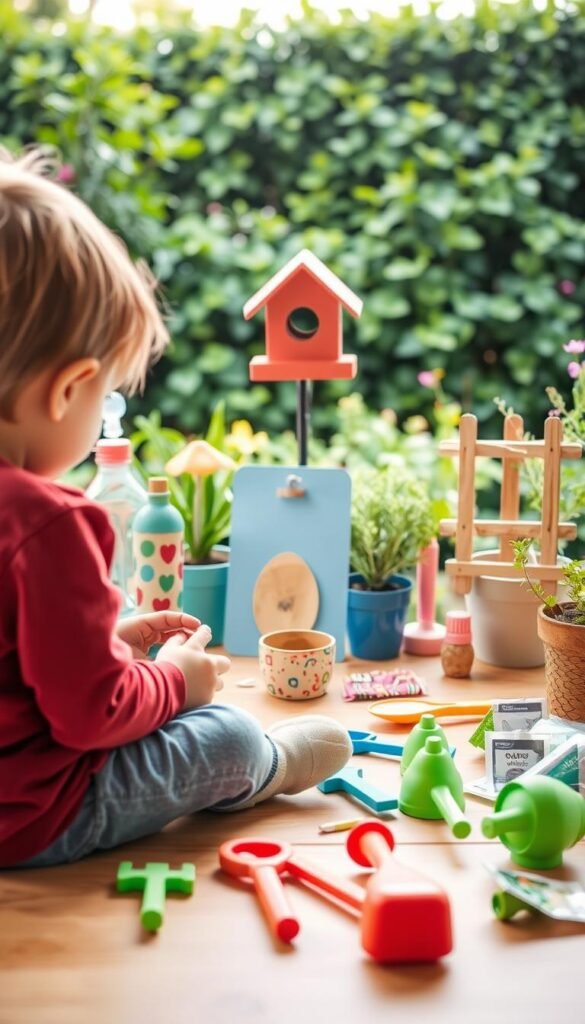Looking for engaging ways to spark your little one’s curiosity? Combining simple creative activities with nature-inspired play offers endless opportunities for growth. Projects like decorating seed pots or crafting paper flowers let kids explore textures and colors while staying clean.
Studies from programs like UBC Farm’s Intergenerational Landed Learning show that hands-on garden activities boost motor skills and creativity in children. Whether you have a backyard or a windowsill, these ideas adapt to any space. Use markers to design plant labels or repurpose scraps for collages—no messy paint required!
Parents love how these projects teach responsibility, like watering small plants or arranging flowers. Best of all, every activity is designed for tiny hands and short attention spans. From seed starters to leafy art, you’ll find options that fit your day and energy level.
Ready to dive in? Discover how easy it is to turn everyday materials into magical garden adventures. Stay tuned for step-by-step guides that blend learning, play, and quality time.
Why Gardening Crafts Engage Toddlers

Nature-based crafts offer a unique blend of sensory play and skill-building for little ones. These hands-on activities let kids interact with natural elements while keeping their surroundings tidy. Whether shaping clay pots or arranging pressed leaves, every project becomes a gateway to discovery.
Exploring Nature in a Safe and Creative Way
Simple projects like creating paper seed envelopes teach children about plant life cycles without dirt-covered hands. Research from educational programs shows that tracing leaf patterns or sorting seeds helps develop observation skills. These tasks turn ordinary materials into tools for understanding weather, growth, and ecosystems.
Many schools use recycled paper strips for weaving mini garden baskets—combining texture exploration with eco-awareness. At home, pressing flowers between wax sheets becomes both art and science. Kids learn responsibility through daily checks on their creations’ progress.
Building Motor Skills and Confidence
Pinching clay into plant markers strengthens finger muscles needed for writing. Using child-safe markers to decorate pots improves grip control. When little ones see their painted rocks brightening the garden path, they beam with pride.
Group projects like building a fairy house from twigs teach teamwork. Completing these crafts gives kids tangible proof of their capabilities. As they arrange petals into colorful collages, they’re not just making art—they’re growing confidence leaf by leaf.
Top Materials and Safety Tips for Mess-Free Projects

Creating with little ones doesn’t have to mean chaos. With the right tools and preparation, you can turn craft time into joyful exploration while keeping your space tidy. Let’s break down how to choose safe supplies and streamline clean-up.
Selecting Child-Friendly Supplies
Start with non-toxic materials like recycled paper, washable markers, and air-dry clay. These items are easy to handle and won’t harm curious kids if touched or tasted. For vertical container gardening hacks, use lightweight pots or fabric scraps instead of breakable ceramics.
Look for rounded scissors and chunky glue sticks designed for small hands. Natural elements like dried seeds or fallen leaves add texture without creating clutter. Always check labels for ASTM D-4236 certification—this ensures art supplies meet safety standards.
Simple Clean-Up Strategies
Set up a dedicated craft zone using a plastic tray or old baking sheet. This contains spills and makes wiping surfaces a breeze. Keep a damp cloth nearby for quick clean-ups during projects.
Use washable tablecloths or newspaper to protect floors. For sticky situations, like glue mishaps, keep a spray bottle of water handy—it loosens dried messes instantly. Involve toddlers in tidying by turning it into a game: “Who can collect the most paper scraps in 30 seconds?”
With these tips, you’ll spend less time scrubbing and more time enjoying those bright-eyed “Look what I made!” moments.
Gardening Crafts for Toddlers: Fun and Mess-Free Projects

Transform ordinary household items into exciting garden-themed creations that spark imagination. These activities blend texture exploration with basic botany lessons, perfect for curious kids who love tactile experiences.
Paper, Clay, and Textile Craft Ideas
Turn recycled paper cups into chia pets by gluing grass seeds to their sides—watch sprouts form “hair” in days. Mold air-dry clay into animal-shaped plant markers, then let your child paint them with washable markers. Old fabric scraps become colorful garden flags when tied to sticks.
Pressed flowers make stunning suncatchers. Sandwich blooms between wax paper and let little hands smooth them flat. This art project teaches patience as they observe changes over time.
Innovative Indoor and Outdoor Projects
Create mini ecosystems in glass jars using layers of soil, pebbles, and small plants. These self-contained worlds thrive on windowsills. For outdoor spaces, repurpose tin cans into vertical herb gardens—drill drainage holes together for teamwork practice.
Potato stamps turn into nature patterns. Carve simple leaf shapes, dip in non-toxic paint, and decorate plain pots. Use coffee filters as disposable work surfaces to contain any mess.
Let your kids personalize projects by choosing seed varieties or arranging painted rocks around garden beds. These hands-on crafts build ownership while keeping play areas tidy.
Adapting Crafts for Different Ages and Skill Levels

Tailoring activities to your child’s developmental stage keeps everyone engaged and safe. Younger kids need projects with chunky materials and instant results, while older ones thrive on detailed tasks. This approach builds confidence and prevents frustration.
Modifying Projects for Little Hands
For toddlers, swap small seeds with large beans when creating plantable paper. Use sticker sheets instead of glue for leaf collages. These tweaks reduce mess while letting children participate fully.
Create a simple comparison guide for multi-age groups:
| Ages 2-3 | Ages 4-5 | Ages 6+ |
|---|---|---|
| Stamping with celery ends | Decorating clay pots | Building mini greenhouses |
| Sorting large seeds | Weaving plant markers | Designing garden maps |
| Watering with spray bottles | Arranging flower petals | Propagating plant cuttings |
Older kids can handle child-safe scissors for cutting fabric garden flags. Let them choose which plants to grow, fostering decision-making skills. Always pair adult tools with supervision.
Adapted activities help families enjoy the same project at different levels. A seed-planting day becomes magical when toddlers press beans into soil while siblings journal growth stages. These shared experiences make gardening memories blossom.
Creative Ways to Involve Your Family and Garden

Bringing generations together through garden projects creates lasting bonds and shared memories. These activities let everyone contribute their unique skills while transforming your outdoor space into a collaborative masterpiece.
Group Projects That Spark Imagination
Build a fairy village using twigs, pebbles, and repurposed containers. Assign roles: kids design tiny doors while adults assemble structures. This project teaches teamwork as you create whimsical habitats for imaginary creatures.
Construct bug hotels from stacked wooden pallets or bamboo tubes. Fill compartments with pinecones and dried leaves to attract beneficial insects. Families can track visiting pollinators together, turning art into science lessons.
Transforming Everyday Materials into Garden Art
Turn tin cans into vertical herb planters by painting them with weather-resistant paint. Let kids arrange the colorful containers on a sunny wall. Old buckets become blooming towers when filled with trailing flowers like petunias.
Use this guide to repurpose household items:
| Recycled Material | Project Idea | Skills Developed |
|---|---|---|
| Plastic bottles | Bug observation stations | Scientific inquiry |
| Milk jugs | Seed starter greenhouses | Responsibility |
| Old colanders | Hanging succulent gardens | Design thinking |
Challenge relatives to create plant-themed sculptures from kitchen scraps. Dry pasta becomes sunflower centers, while cereal boxes transform into 3D leaf mobiles. These activities prove that creativity grows best when nurtured together.
Final Thoughts and Growing a Love for Gardening
Nurturing a child’s curiosity through garden-inspired crafts leaves lasting impressions beyond sticky fingers. These projects build fine motor skills as little hands fold paper seed envelopes or press petals into collages. Creativity blossoms when arranging flowers or painting rocks for outdoor displays.
What makes these activities special? They thrive in any space—sunny windowsills, balconies, or picnic tables. Rainy days become opportunities to design leaf patterns, while sunny afternoons transform into seed-planting adventures. Shared time spent crafting together plants memories that grow alongside sprouting plants.
Simple moments—like watching seeds sprout in decorated pots—teach patience and care. These experiences quietly root a lifelong appreciation for nature’s cycles. As seasons change, so can your crafts: spring bud collages, summer herb markers, autumn leaf prints.
Your garden becomes more than soil and flowers. It’s a living classroom where imagination meets earth. Every painted stone or woven twig tower adds personality to this shared space. Start small, experiment freely, and watch both your garden and child’s confidence flourish.






